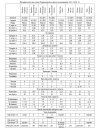@GAZ Vodnik
Well, speed in the Age of Sail was primarily a function of waterline length (with displacement/sail area ratio thrown in for good measure), so, sure, a SoL could sail as fast or even faster than a frigate. And with a greater displacement, they had a built-in advantage in heavy seas or when sailing into a head sea.
Based on contemporary sailing reports, out of the Ships of the Line in Naval Action, the Wasa should be the fastest sailer (especially close-hauled) and the one with the best turn-rate, followed by the Bellona.
Rated by speed on a broad reach, the fastest ship historically was Endymion, followed by La Renommée, Prince, Belle Poule, Trinc, Wasa and Hermione.
Close-hauled, Endymion, Prince, Wasa, Belle Poule.
But smaller ships like the Prince de Neufchatel or La Renommée needed smooth water to reach their top speed, otherwise they were relatively easy prey for bigger ships (the former was captured by the Leander of 56 guns, the latter by the Dover of 44 guns)
By the way, the worst frigate in terms of sailing should be Surprise/ex-L'Unité, the worst SoL Santissima Trinidad. The latter was pretty much a haystack with sails after her conversion to a 4-decker.
The Wappen von Hamburg is complete ****-****, they took the plans of a generic british 60-gun ship, gave it the stern of the model of the WvH III and over-gunned till kingdome come. The original, a vessel made for convoy duty, not for the line of battle, carried 6 18-pounders, 16 12-pounders. 26 8-pounders and 4 3-pounders, which is a far cry from the ship in-game.















